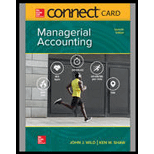
Journal: A journal is the complete record of a financial transaction which shows the debit and credit of respective accounts for every transaction including the explanation of the transaction.
T-Accounts: An account is a unique record of increases or decreases in any asset, liability, equity, revenues or expenses. T-accounts are drawn to resemble a T-shape with debit on the left and credit on the right. Assets and expenses have normally debit balances and liability, equity and revenue accounts have normally credit balance.
To analyze:
The given transaction using accounting equation.
Journal: A journal is the complete record of a financial transaction which shows the debit and credit of respective accounts for every transaction including the explanation of the transaction.
T-Accounts: An account is a unique record of increases or decreases in any asset, liability, equity, revenues or expenses. T-accounts are drawn to resemble a T-shape with debit on the left and credit on the right. Assets and expenses have normally debit balances and liability, equity and revenue accounts have normally credit balance.
To prepare:
Journal Entries for the given transaction.
Accounting Equation: Accounting equation is also known as balance sheet equation. Accounting equation is based on the principles of double entry system of accounting. The accounting equation is as follows
Journal: A journal is the complete record of a financial transaction which shows the debit and credit of respective accounts for every transaction including the explanation of the transaction.
T-Accounts: An account is a unique record of increases or decreases in any asset, liability, equity, revenues or expenses. T-accounts are drawn to resemble a T-shape with debit on the left and credit on the right. Assets and expenses have normally debit balances and liability, equity and revenue accounts have normally credit balance.
To prepare:
T-accounts for the given transactions.
Want to see the full answer?
Check out a sample textbook solution
Chapter D Solutions
Managerial Accounting - Connect Access
- What is the cash conversion cycle for the firmarrow_forwardDelta Tools estimated its manufacturing overhead for the year to be $875,500. At the end of the year, actual direct labor hours were 49,600 hours, and the actual manufacturing overhead was $948,000. Manufacturing overhead for the year was overapplied by $81,400. If the predetermined overhead rate is based on direct labor hours, then the estimated direct labor hours at the beginning of the year used in the predetermined overhead rate must have been _.arrow_forwardWhat is the depreciation expense for 2022arrow_forward
- Can you solve this financial accounting question with the appropriate financial analysis techniques?arrow_forwardJulius provided consulting services amounting to P420, 000. His total expenses were 25%. His net income is: A. P105,000 B. P300,000 C. P315,000 D. P120,000arrow_forwardWhat is the cost of goods soldarrow_forward
- SnapGallery Inc. sells one digital poster frame. The sales price per unit is $12. The variable cost per unit is $7. Fixed costs per annum are $13,500 and having a sales volume of 5,000 digital poster frames would result in: 1. a profit of $11,500 2. a loss of $2,500 3. breaking even 4. a profit of $8,000arrow_forwardWhat would be the bas debt expense for the yeararrow_forwardHow much overhead was applied during the year?arrow_forward
 Individual Income TaxesAccountingISBN:9780357109731Author:HoffmanPublisher:CENGAGE LEARNING - CONSIGNMENT
Individual Income TaxesAccountingISBN:9780357109731Author:HoffmanPublisher:CENGAGE LEARNING - CONSIGNMENT Intermediate Accounting: Reporting And AnalysisAccountingISBN:9781337788281Author:James M. Wahlen, Jefferson P. Jones, Donald PagachPublisher:Cengage LearningPrinciples of Accounting Volume 1AccountingISBN:9781947172685Author:OpenStaxPublisher:OpenStax College
Intermediate Accounting: Reporting And AnalysisAccountingISBN:9781337788281Author:James M. Wahlen, Jefferson P. Jones, Donald PagachPublisher:Cengage LearningPrinciples of Accounting Volume 1AccountingISBN:9781947172685Author:OpenStaxPublisher:OpenStax College College Accounting (Book Only): A Career ApproachAccountingISBN:9781337280570Author:Scott, Cathy J.Publisher:South-Western College Pub
College Accounting (Book Only): A Career ApproachAccountingISBN:9781337280570Author:Scott, Cathy J.Publisher:South-Western College Pub





